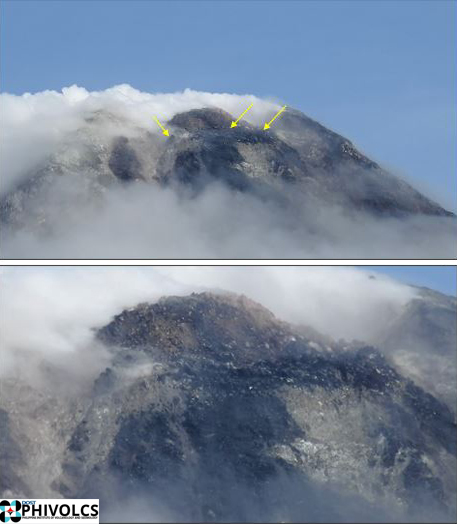Report on Mayon (Philippines) — December 2022
Bulletin of the Global Volcanism Network, vol. 47, no. 12 (December 2022)
Managing Editor: Benjamin Andrews.
Edited by Kadie L. Bennis.
Mayon (Philippines) Lava dome growth and gas-and-steam emissions during August-November 2022
Please cite this report as:
Global Volcanism Program, 2022. Report on Mayon (Philippines) (Bennis, K.L., and Andrews, B., eds.). Bulletin of the Global Volcanism Network, 47:12. Smithsonian Institution.
Mayon
Philippines
13.257°N, 123.685°E; summit elev. 2462 m
All times are local (unless otherwise noted)
Mayon, located in the Philippines, has steep upper slopes capped by a small summit crater. Recorded eruptions date back to 1616 CE and are characterized by Strombolian eruptions, lava flows, pyroclastic flows, and mudflows. Eruptions mostly originated from a central conduit. Pyroclastic flows and mudflows have commonly descended many of the approximately 40 drainages that surround the volcano. The most recent eruption occurred during January 2018 through October 2019 and included phreatic explosions, gas-and-ash plumes, lava fountaining, and pyroclastic flows (BGVN 43:04). Based on ground deformation parameters from EDM, Precise Leveling, electronic tilt and continuous GPS monitoring, slight inflation has been observed since 2020. More recent activity has been relatively low, consisting of small thermal anomalies, gas-and-steam plumes, and some inflation (BGVN 44:11). This report covers a new eruption during June through November 2022 using daily bulletins from the Philippine Institute of Volcanology and Seismology (PHIVOLCS).
Low activity was reported during June; minor inflation, particularly on the NW and SE flanks have been recorded since April 2022. According to PHIVOLCS, changes in morphology of the summit lava dome emplaced in 2018 resulted in the increase in the Volcano Alert Level (VAL) from 0 to 1 (on a scale of 0-5). Minor extrusion was estimated at about 40,000 cubic meters during 6 June through 20 August, based on daily visual and camera monitoring data. Seismicity was at baseline levels for most of 2022, though short-lived spikes in the number of low-frequency volcanic earthquakes were recorded on 26 May and 20 June. PHIVOLCS reports that based on this data, dome growth was likely the result of gas pressurization at shallow depths.
Activity during August 2022 mostly consisted of moderate gas-and-steam emissions that rose as high as 900 m above the crater and drifted in different directions. Weather clouds often obscured the summit, thus crater incandescence could not be determined on a majority of days during early-to-mid-August. Sulfur dioxide emissions were measured on 12 August and were an average of 688 tons/day (t/d). During 25-31 August faint crater incandescence was reported based on telescope observations. Sulfur dioxide emissions decreased to 195 t/d based on measurements made on 30 August. Similar low activity continued during September; moderate gas-and-steam emissions rose 100-300 m and drifted in multiple directions. Faint crater incandescence was visible based on telescope observations on clear weather days. A single volcanic earthquake was detected on each day during 6-8, 13, 23-24, and 29 September. Sulfur dioxide emissions were measured on 6, 7, 13, and 24 September and ranged between 339 t/d and 599 t/d. Three volcanic earthquakes were detected on 26 September.
During October, moderate gas-and-steam emissions rose 200-800 m above the crater and drifted in different directions. Sulfur dioxide measurements were made on 1, 12, 13 October with values that ranged from 260 t/d to 391 t/d. Beginning on 2 October, re-mobilized, light-colored ash was deposited in Miisi Gully (S flank), which was likely derived from lava fragmentation as the lava dome continued to grow, according to PHIVOLCS. Three volcanic earthquakes were detected on 3 October. Daily visual and camera monitoring data showed that the lava dome grew an additional 48,000 cubic meters during 20 August through 4 October. One volcanic earthquake was detected each day on 5, 6, 17, and 23 October. Occasional faint crater incandescence was visible in clear weather and sometimes when using a telescope. On 7 October an aerial survey was conducted and reported that freshly extruded lava was visible at the base of the summit lava dome (figure 51). As a result, the VAL was raised to a 2 (on a 0-5 scale). There were two volcanic earthquakes detected each day on 19 and 22 October.
 |
Figure 51. Aerial photos showing the summit lava dome at Mayon on 7 October 2022 with fresh lava effusions at the base (yellow arrows). Courtesy of PHIVOLCS. |
Faint crater incandescence persisted on clear weather days during November. Gas-and-steam emissions also continued, rising 200-250 m above the crater and drifting NE, WNW, WSW, W, and SW. Three volcanic earthquakes were detected each day on 1 and 12 November. Sulfur dioxide emissions were measured on 3 and 23 November with values that ranged from 276 t/d to 788 t/d. A single volcanic earthquake was detected each day on 7, 10, 14, and 28 November.
Geological Summary. Symmetrical Mayon, which rises above the Albay Gulf NW of Legazpi City, is the most active volcano of the Philippines. The steep upper slopes are capped by a small summit crater. Recorded eruptions since 1616 CE range from Strombolian to basaltic Plinian, with cyclical activity beginning with basaltic eruptions, followed by longer term andesitic lava flows. Eruptions occur predominately from the central conduit and have also produced lava flows that travel far down the flanks. Pyroclastic flows and mudflows have commonly swept down many of the approximately 40 ravines that radiate from the summit and have often damaged populated lowland areas. A violent eruption in 1814 killed more than 1,200 people and devastated several towns.
Information Contacts: Philippine Institute of Volcanology and Seismology (PHIVOLCS), Department of Science and Technology, University of the Philippines Campus, Diliman, Quezon City, Philippines (URL: http://www.phivolcs.dost.gov.ph/).

